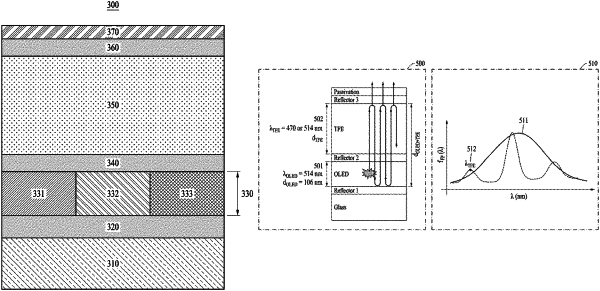| CPC H10K 50/852 (2023.02) [H10K 50/11 (2023.02); H10K 50/818 (2023.02); H10K 50/828 (2023.02)] | 10 Claims |

|
1. An optoelectronic device, wherein the optoelectronic device is applied to a self-emissive device, and the optoelectronic device comprises:
a first reflector layer;
a first self-emissive device in which an active cavity layer is formed on the first reflector layer;
a second self-emissive device in which a second reflector layer is formed on the active cavity layer;
a third self-emissive device in which an external cavity layer is formed on the second reflector layer;
a third reflector layer formed on the external cavity layer; and
a passivation layer formed on the third reflector layer,
wherein the optoelectronic device generates a first micro-cavity corresponding to the first and second reflector layers and a second micro-cavity corresponding to the second and third reflector layers,
wherein the active cavity layer comprises a first active cavity layer, a second active cavity layer, and a third active cavity layer, and in consideration of optical and electrical characteristics of the active cavity layer, the first micro-cavity is designed for a first-order resonance mode, generating light based on a resonance phenomenon according to the first-order resonance mode within the first to the third self-emissive devices,
wherein at least one of the first to the third self-emissive devices has a same thickness, reflecting a photoluminescence spectrum of a luminescent material, thereby adjusting a primary emission spectrum, which is then propagated to the second reflector layer,
wherein the external cavity layer is designed for multiple resonance modes to form multiple peaks in a visible range, controlled by an effective optical distance due to a thickness variation of the external cavity layer, forming resonance modes in a wavelength range corresponding to luminescent peaks of at least one of the first to the third self-emissive devices based on the multiple resonance modes, simultaneously forming spectral peaks for a secondary resonance phenomenon, and
wherein the secondary resonance phenomenon is reflected on the generated light propagated through the second reflector layer, adjusting the emission spectrum of the first to the third self-emissive devices in a secondary manner, designing the first-order resonance mode according to the thickness of the active cavity layer, thereby controlling the size of the peaks according to the secondary resonance phenomenon differently in at least one of the first to the third self-emissive devices.
|